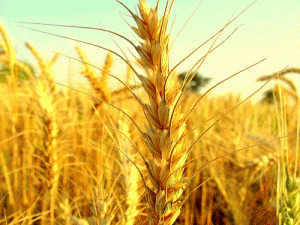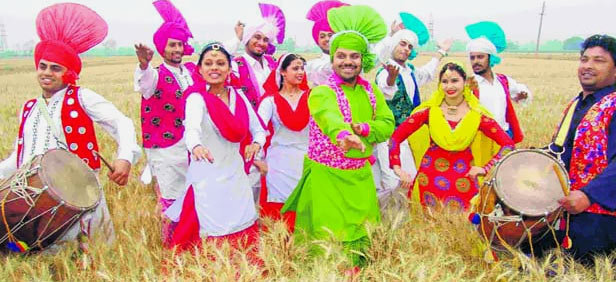 In April, this day marks the beginning of the Hindu solar New Year. In fact this day is celebrated all over the country as New Year day under different names. It is also the time when the harvest is ready to cut and store or sell. Baisakhi is perhaps one of the most vibrant and joyful festivals for the Punjabis and Sikhs. It is also known as ‘Punjabi New Year’ or ‘Vaisakhi’. It falls during the first month ofPunjabcalendar ‘Vaisakh’, according to Nanakshahi the Sikh Calendar. This day normally falls on April 13. Once in 36 years, it is celebrated in April
In April, this day marks the beginning of the Hindu solar New Year. In fact this day is celebrated all over the country as New Year day under different names. It is also the time when the harvest is ready to cut and store or sell. Baisakhi is perhaps one of the most vibrant and joyful festivals for the Punjabis and Sikhs. It is also known as ‘Punjabi New Year’ or ‘Vaisakhi’. It falls during the first month ofPunjabcalendar ‘Vaisakh’, according to Nanakshahi the Sikh Calendar. This day normally falls on April 13. Once in 36 years, it is celebrated in April
About Baisakhi History
 Baisakhi or Vaisakhi Festival is celebrated as the Sikh New Year and the founding of the Khalsa Panth. For the Sikh community, it is the birthday of their tenth Guru, Guru Gobind Singh. On this day, in 1699, he founded the Panth Khalsa the order of Pure ones. Sikhs visits gurdwaras and listen to kirtans (devotional songs). They listen to the recitations from the Guru Granth Sahib. After the prayers, they eat kada prasad (sweetened semolina) offered to the entire community. They sit down together for the traditional langar cooked and served by the volunteers both young and old alike. For Hindus, it’s the start of the New Year, and is celebrated with requisite bathing, partying, and worshipping. It’s believed that the goddess Ganga descended to earth thousands of years ago, and in her honor many Hindus gather along the sacred Gange sRiver for ritual baths. The action is centered in the holy cities along the Ganges in north India.
Baisakhi or Vaisakhi Festival is celebrated as the Sikh New Year and the founding of the Khalsa Panth. For the Sikh community, it is the birthday of their tenth Guru, Guru Gobind Singh. On this day, in 1699, he founded the Panth Khalsa the order of Pure ones. Sikhs visits gurdwaras and listen to kirtans (devotional songs). They listen to the recitations from the Guru Granth Sahib. After the prayers, they eat kada prasad (sweetened semolina) offered to the entire community. They sit down together for the traditional langar cooked and served by the volunteers both young and old alike. For Hindus, it’s the start of the New Year, and is celebrated with requisite bathing, partying, and worshipping. It’s believed that the goddess Ganga descended to earth thousands of years ago, and in her honor many Hindus gather along the sacred Gange sRiver for ritual baths. The action is centered in the holy cities along the Ganges in north India.
Hindus plant poles wrapped in flags of god-embroidered silk in front of their homes, and hang pots of brass, copper or silver on top. Children wear garlands of flowers and run through the streets singing “May the new year come again and again!” In Kerala the festival is called Vishu, and includes fireworks, shopping for new clothes and interesting displays called Vishu Kani. These are arrangements of flowers, grains, fruits, cloth, gold, and money are viewed early in the morning, to ensure a year of prosperity. InAssam, the festival is called Bohag Bihu, and the community organizes massive feasts, music, and dancing.
On Baisakhi day, sacred Guru Granth Sahib is taken out in a procession. At the head of the procession are the Panj Piaras, symbolizing the journey made by the five fearless devotees from their homes to Anandpur. Men, women and children alike with faith and enthusiasm attend these processions. They move through major localities of the city and is welcomed by citizens and members of social and cultural societies.
Colourful bhangra and gidda dance apart from mock duels are performed during Baisakhi processions. The fascinating and colourful of this procession is marked by religious songs, dances and men swinging swords. Loud Sikh chants of ‘Bole so nihal’, ‘Deg teg fateh’ and rhythmic chants of ‘Sat nam’ and ‘Wahe guru’ ring out from the middle of the singing and drumming.
Baisakhi Fairs
In Punjab, Baisakhi Fairs are extremely popular. People come with their family and friends from far off places come to these fairs to witness bhangra and gidda dances, races, wrestling bouts, singing and acrobatics. They listen to the folk instruments, such as vanjli and algoza.
Visiting Gurdwara
It is then time to visit gurudwaras where kirtans (singing of hymns) are held and kada prasad is distributed. People perform Kar Sewa (physical labour to help in the daily chores of the gurudwara as a symbol of humility) in gurudwaras and listen to recitations from Guru Granth Sahib. Colourful processions, led by the Panj Piaras, are taken out. Children and youth demonstrate their skills in martial arts to the accompaniment of musical bands. Children are taught to perform acts of charity on this auspicious Occasion and are expected to continue to do so all through the year.
Best Places to Visit on Baisakhi
One can visit Golden Temple in Amritsar,Punjab and enjoy the Energetic Bhangra and Gidda performances and the very tasteful Punjabi cuisine.
Submit your review | |

